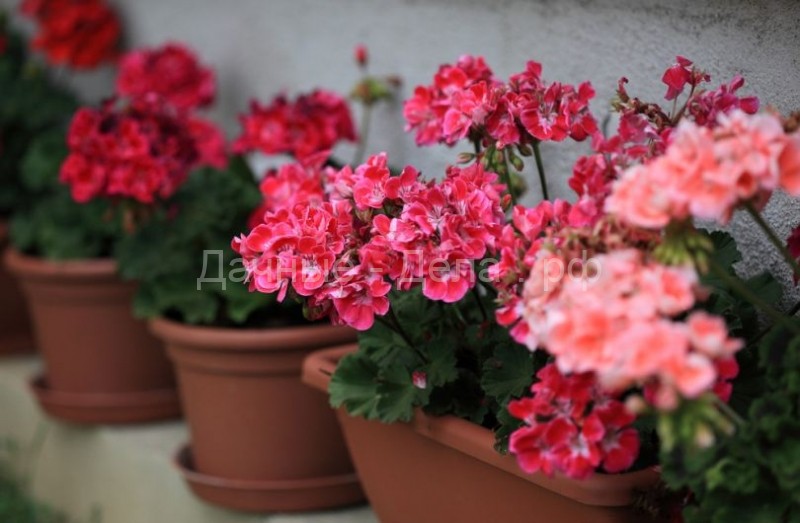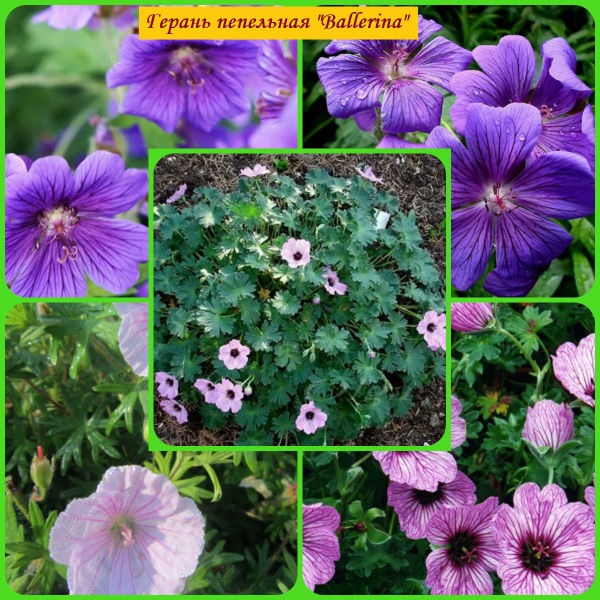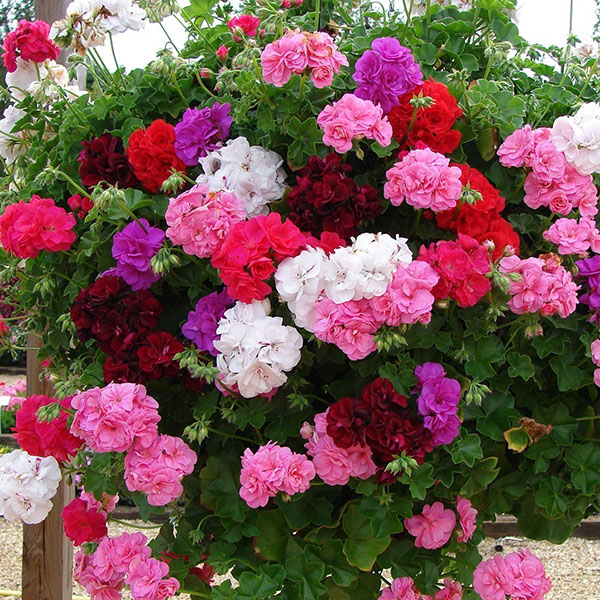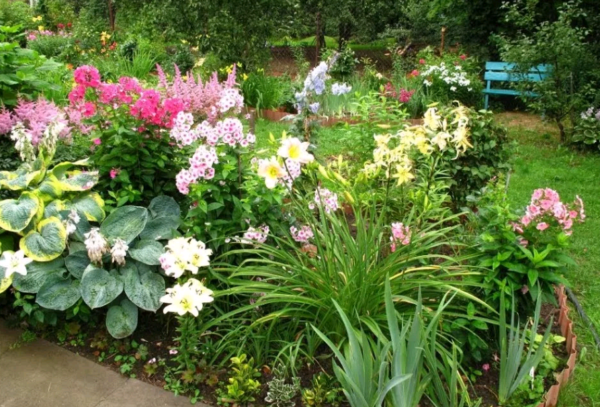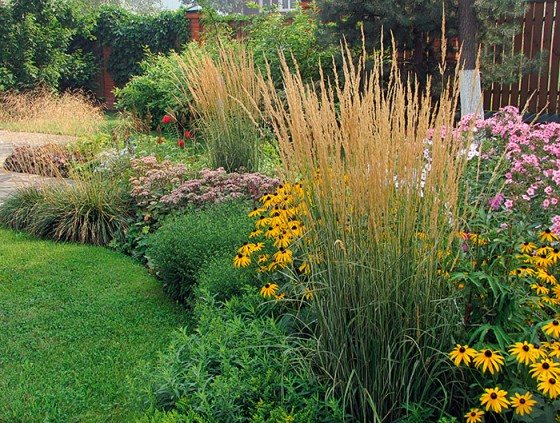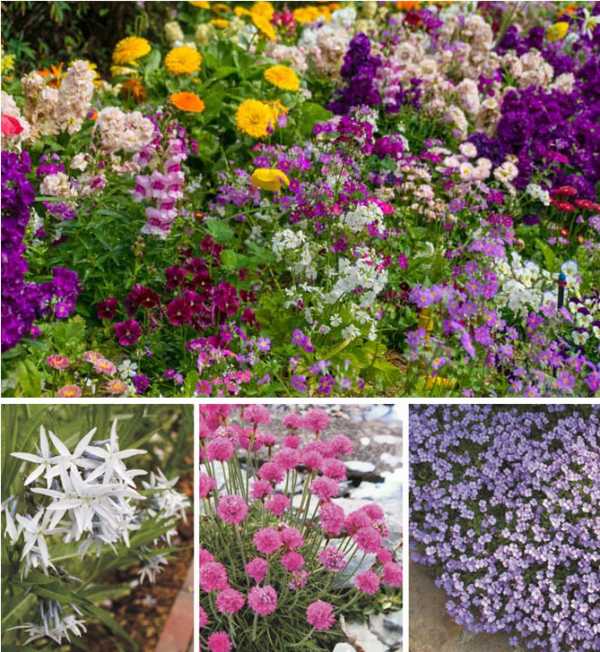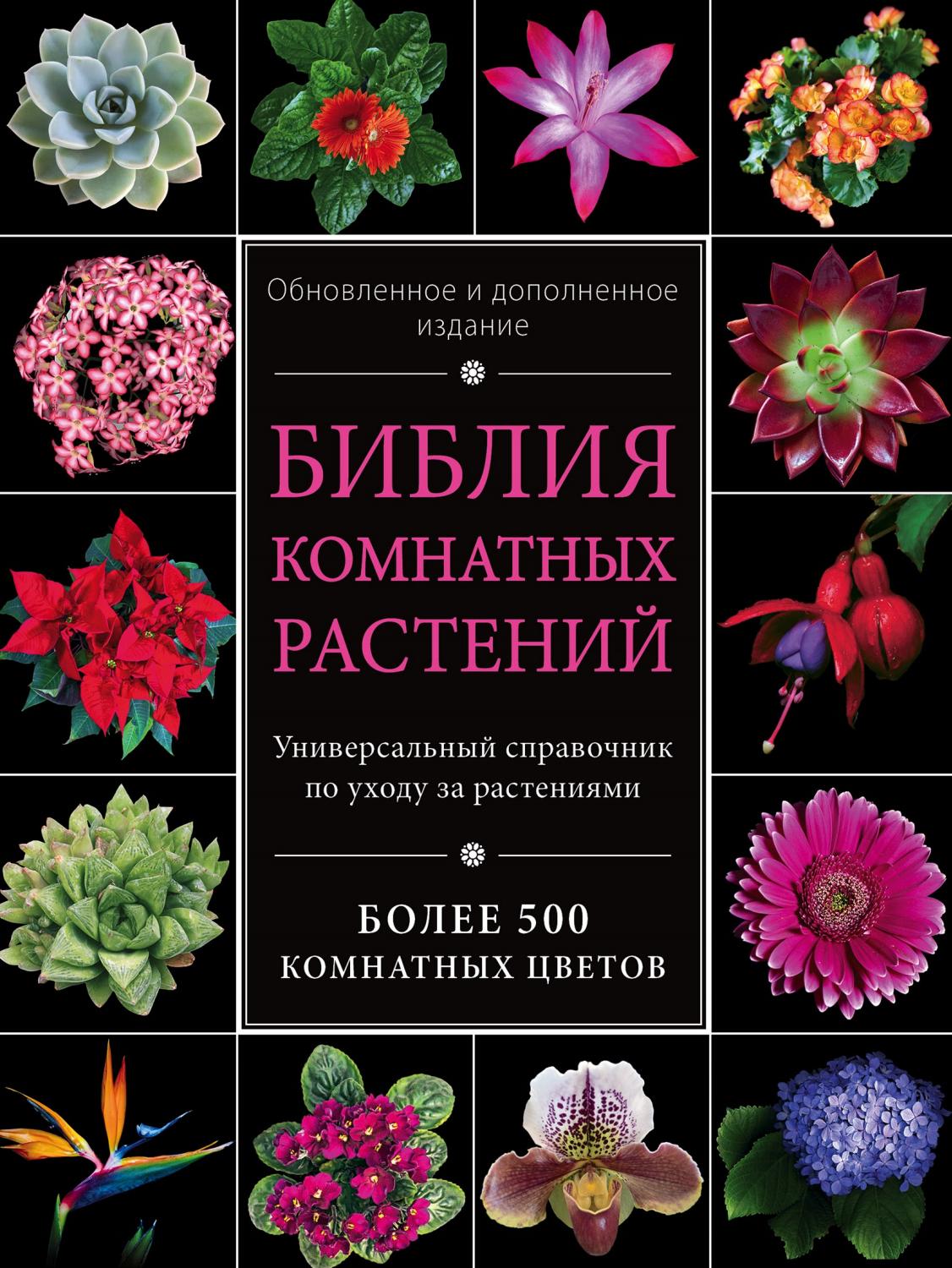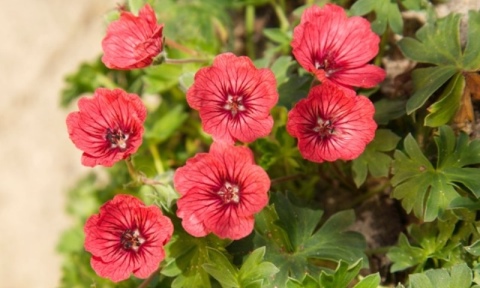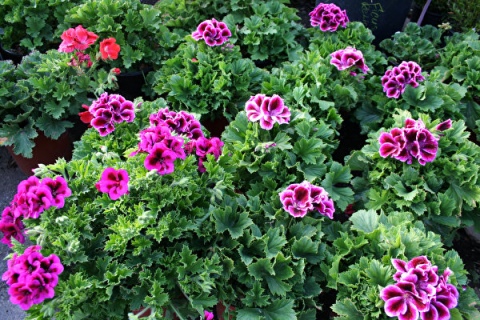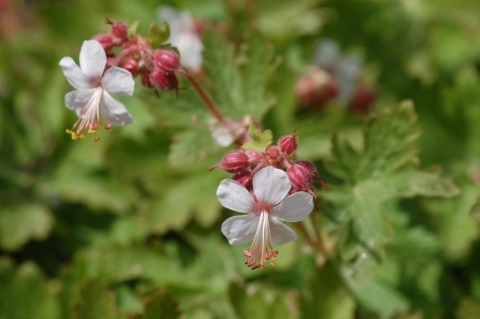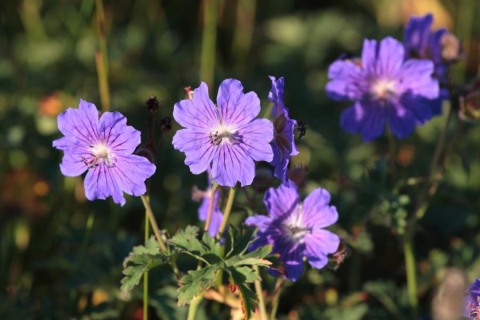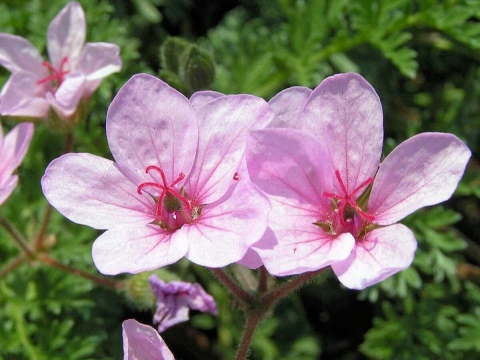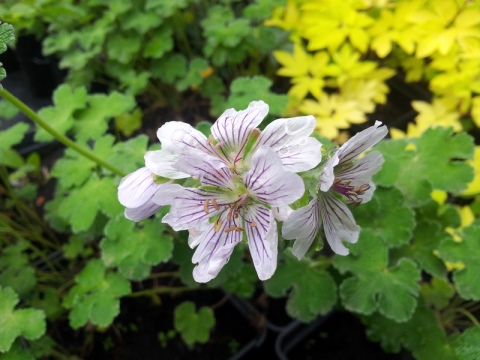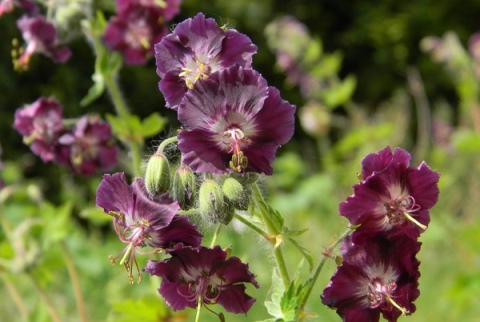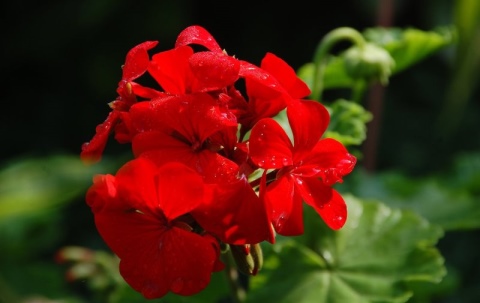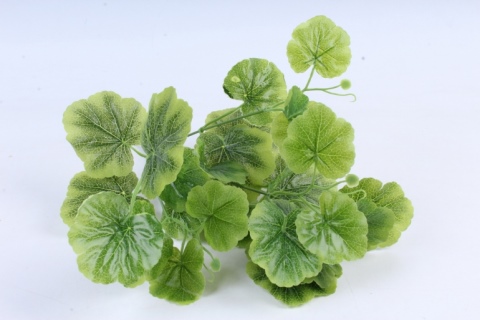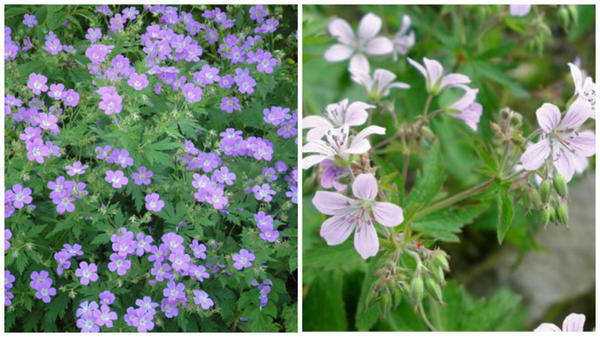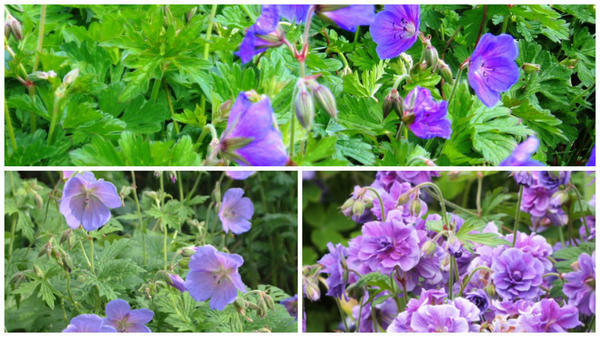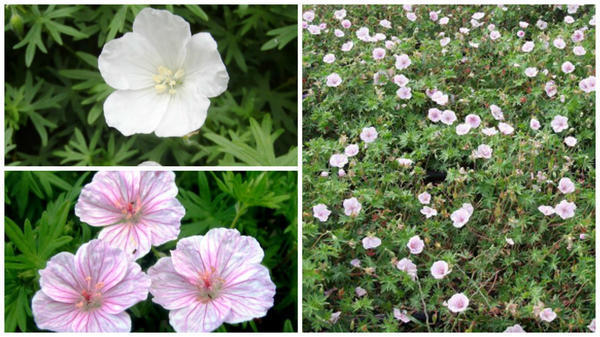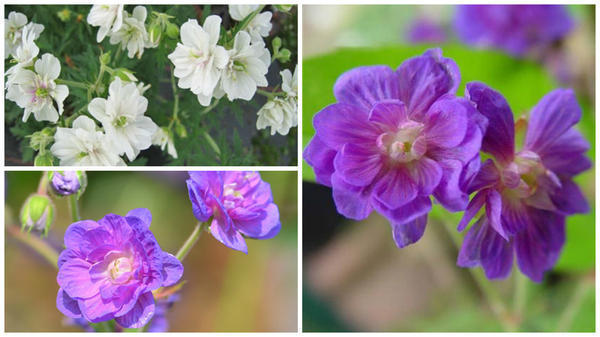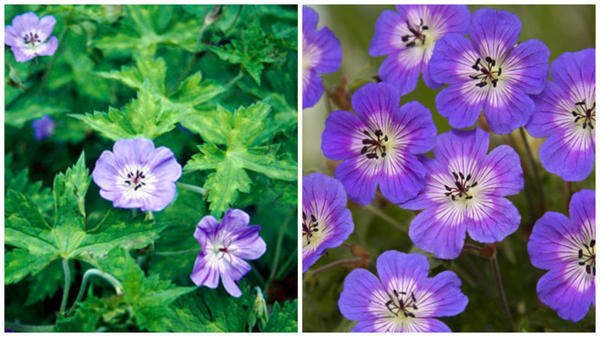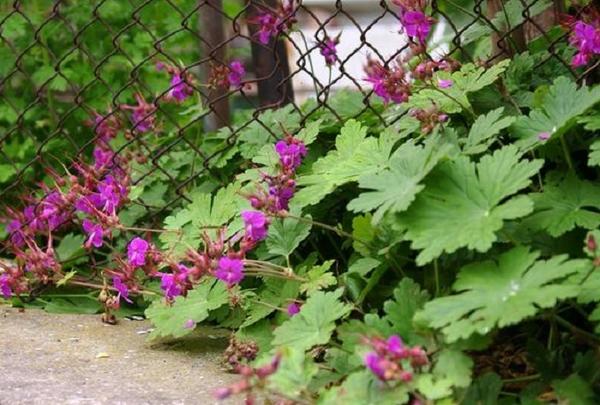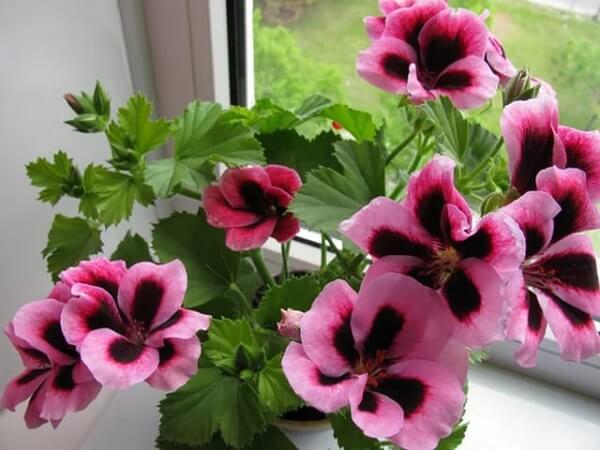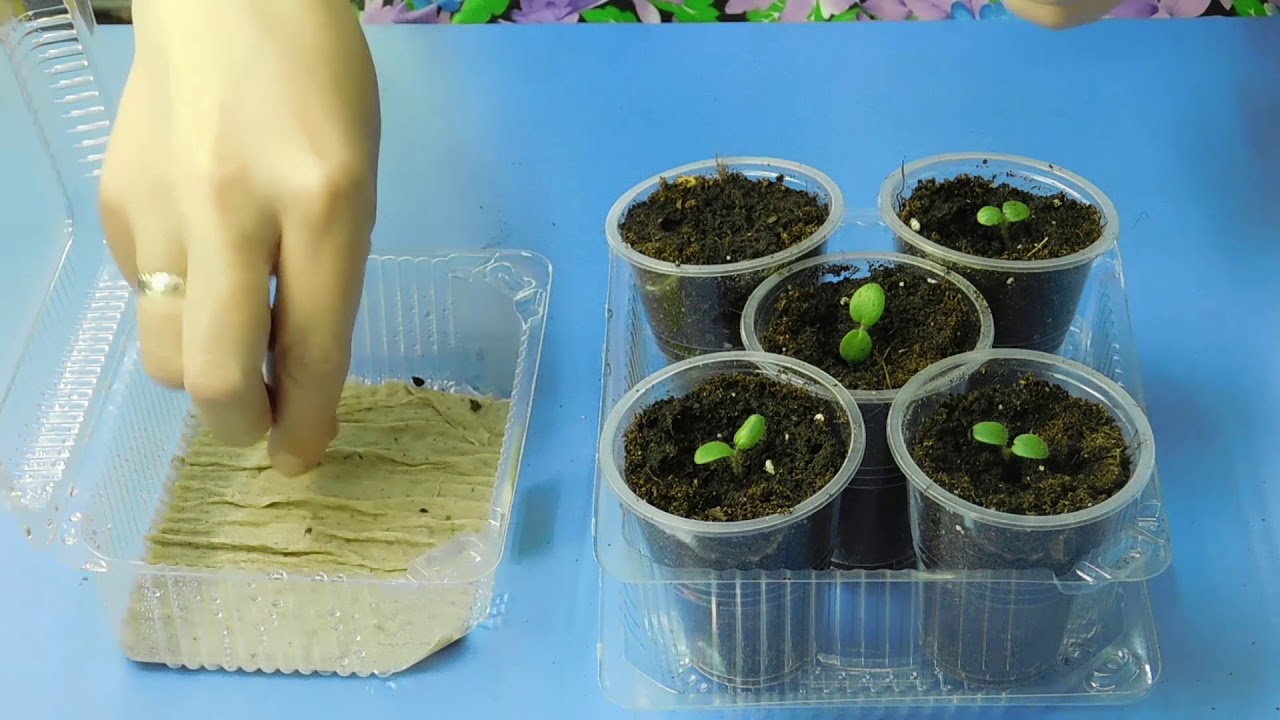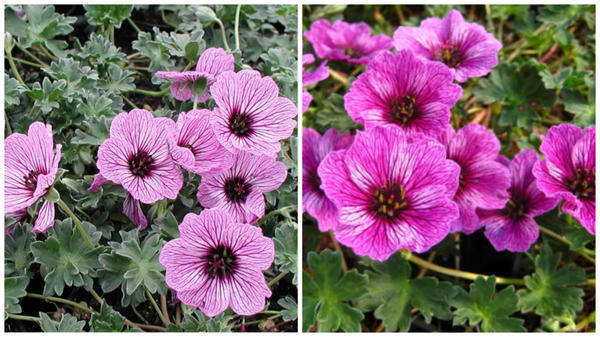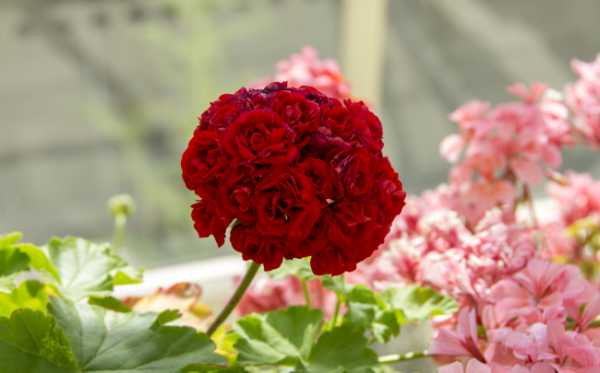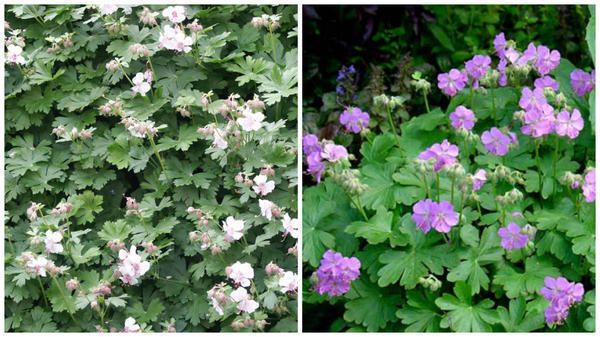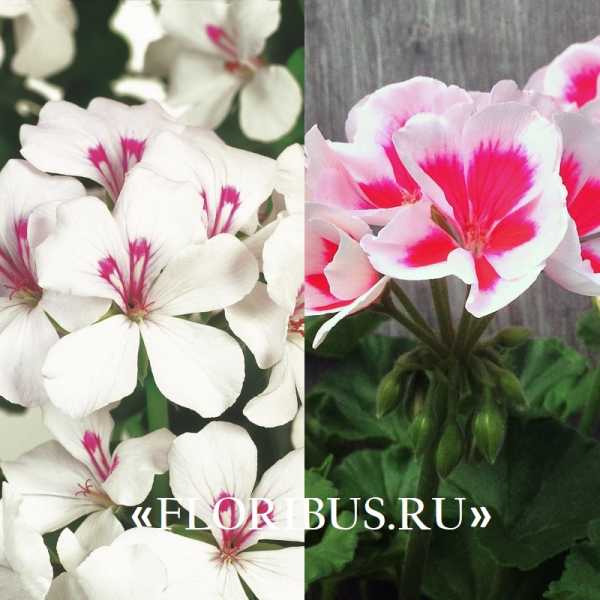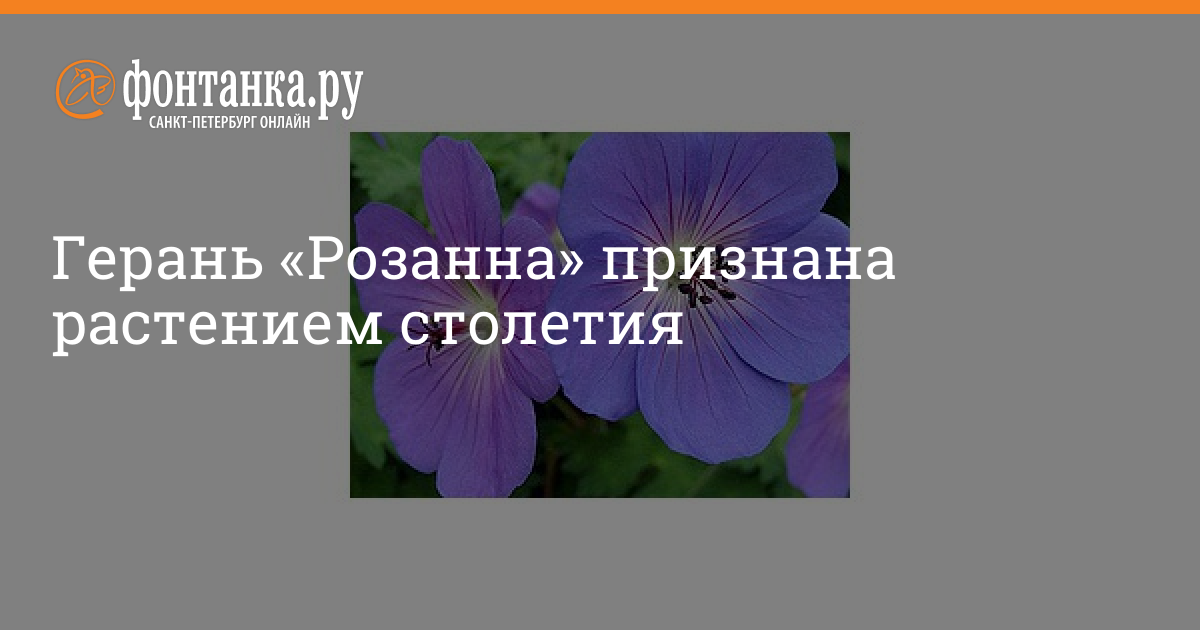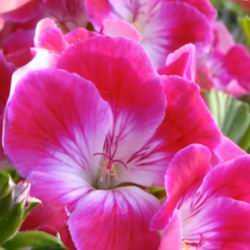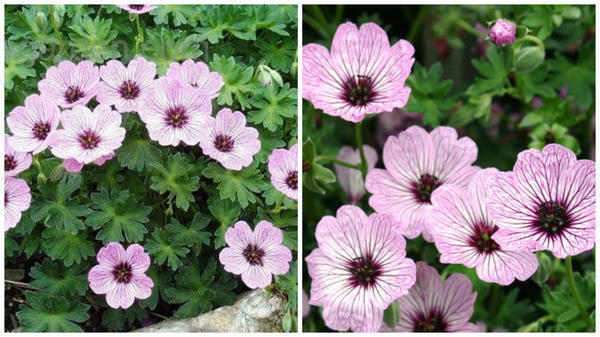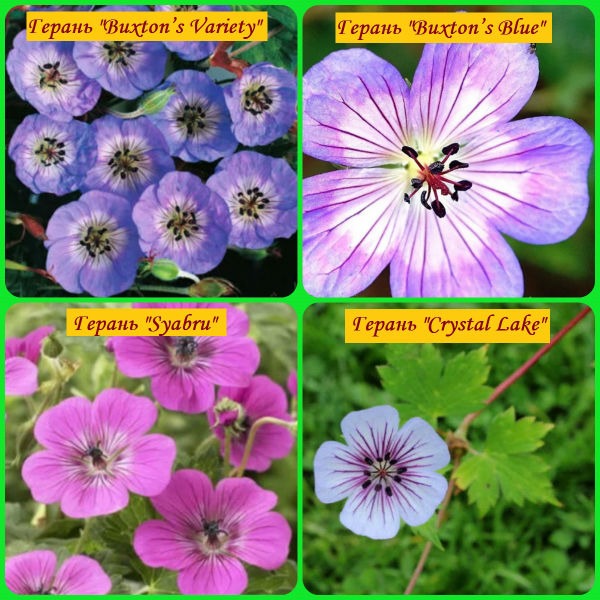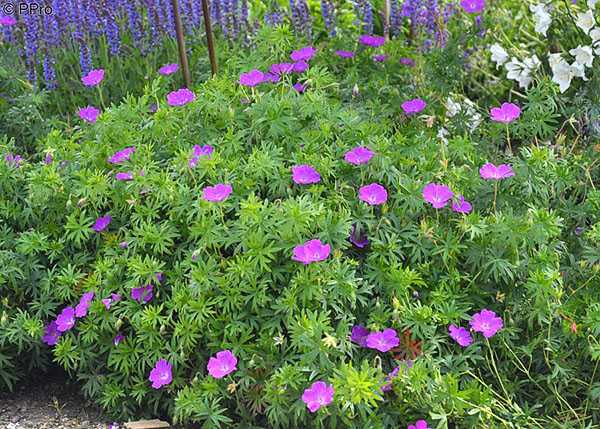Breeding features
Geranium reproduces in two main ways:
- Seminal.
The negative aspect of this method of propagation is that future plants will not always repeat the parental properties of the hybrid.
- Cuttings.
This method can be used all year round.
Seeds
- The seeds are sown in specially prepared soil. For this, peat, sand, and double the size of sod land are taken in equal parts.
- The bottom of the cookware is drained.
- The seeds are placed at a distance of 2 cm from each other, sprinkled with earth on top and watered with a spray bottle.
- After that, you need to cover the seeds with foil or dishes and create a temperature of +20 degrees. The shelter is cleaned daily and the soil is ventilated.
- As soon as the seeds germinate, the shelter is removed altogether and the air temperature drops.
Cuttings
This is done all year round, but it is in the spring that the roots on the cuttings form faster.
- After cutting the cutting, it is left in the air for 2 hours so that the cutting site dries up.
- Planting is carried out in a container with loose soil or coarse sand.
- You don't need to cover him.
After rooting, the cutting can be transplanted into another container.
Geranium is incredibly fragrant and beautiful and a flower that can often be seen in flower beds and balconies. The abundance of species and varieties of this plant is surprising. In a number of separate articles on our website you can learn about the interesting Plenum geraniums, Angel hybrids, Perennials Pionovidny and about the annual Robert, about Roseanne, blooming all summer, you will read how to grow white and black geraniums, what is great about the magnificent Max Fry, how to do it right take care of the fragrant Lemon.
Many gardeners are advised to start planting indoor plants with geraniums. They are unpretentious and will always delight with long and abundant flowering with proper care.
Zoned geranium

The zoned crane is the most popular for home cultivation. He has a lot of varieties. Each variety has its own differences. However, there are some common features: persistence, intense flowering. They are distinguished by a straightened trunk, which is covered with wavy and lowered leaf plates. The leaves have a red-brown border. They give off a specific smell.
The following forms are distinguished:
- Common with five petals;
- Half double with 8 petals;
- Terry, with petals exceeding eight pieces.
The zonal crane also differs in the shape of the flowers:
- Flowers of red and pink shades, similar to roses;
- Similar to tulip buds;
- Reminiscent of a star;
- Narrow, curling petals resembling a chrysanthemum;
- Small flowers grouped in bouquets;
- Asterisks.
Coloring flowers can be as follows:
- One tone;
- Two tones;
- Many tones;
- Flowers with a border;
- With specks;
- With mixing stripes and dots.
The height of the geranium bush can be up to 60 cm if it is a standard plant, up to 10 cm for miniature types. Irene can grow up to 80 cm.
The zonal crane got its name not by chance. The leaves of the plant are distinguished by zones of different colors. Often they have a purple, white border. In the middle, you can see places with a golden, bronze tint.
Pelargonium and geranium - the same thing or not
Pelargonium and geranium are very similar in appearance. However, they differ:
- they cannot be crossed because they are genetically different;
- geranium comes from the northern regions, so it tolerates frost well;
- pelargonium is an inhabitant of southern countries, in winter it should be in a greenhouse or at home;
- Pelargonium is grown on balconies, geranium can feel great in the garden, that's the difference.
The unpretentiousness of the geranium, its high decorative qualities led to the wide distribution of the plant among flower growers. Correctly selected conditions for its growth make it possible to enjoy beautiful and long-lasting flowering.
Types and popular varieties: names and descriptions with photos
Currently, there are many types of garden geranium. Each of them has its own properties and requires different care. Below you can find a description and a photo of the most common varieties of geraniums.
Perennial
Perennial geraniums are very often planted in a summer cottage, since the plant does not require special care, it is very hardy to external unfavorable factors. Under good conditions, garden geranium, unlike its one-year relative, pelargonium, can grow outdoors for up to 10 years.
Reference! The perennial garden geranium has various colors - white, purple, red, pink.
Perennial garden geranium is divided into the following varieties:
- Marsh geranium - has purple flowers.
- Geranium is red-brown - its flowers are dark red.
- Meadow geranium. It has purple flowers with a bluish tint (you can find out about the medicinal properties and contraindications of meadow geranium here).
Groundcover
This type of plant is strong and tenacious, with a long rhizome. In a short time, ground cover geranium grows over large areas of the garden plot. Outwardly, it resembles a variegated carpet, since geranium flowers are bright red or purple.
The diameter of each inflorescence does not exceed 3 cm, the bush grows in height by an average of 30 cm. In June, the beauty begins to bloom, and in August you can collect seeds.
This subspecies is very hardy and not demanding in content. In a flowerbed, geraniums can be successfully combined with other similar plants.
This plant hibernates easily. It does not need to be covered, as it tolerates cold without consequences. Pruning of branches is done before the winter season. Snow is used as a cover material for geraniums.
Undersized
This plant has a strong branched stem. Leaves appear at the very root. The flower has a thick rhizome capable of rapid growth. The surface of the sheet is soft and fibrous. Flower baskets have a diameter of up to 5 cm. The flowers themselves combine several shades, smell nice. Low-growing geranium will perfectly fit into the landscape design of any home.
The most popular varieties of garden low-growing geraniums include:
- Samobor is a flower that has not only standard green leaves, but also dark brown drawing leaves.
- Margaret Wilson - with marble designs on the leaves.
- Lisa has yellow chartreuse spots.
- Rose Clair - the height of the bush reaches 35 cm, geranium blooms with pink-red flowers.
Black Beauty
Under natural conditions, this variety grows in Western Europe and in the European part of Russia.
The bush is distinguished by its spherical shape. The inflorescences are dark and rich. The size of each flower is within 4 cm. Black Beauty blooms until early September. Geranium leaves are rounded, slightly dissected towards the end, light green in color. This variety of geranium goes well with other types of plants in the garden plot.
Soil requirements
White geranium is not demanding on the soil, but it is worth following some recommendations on the composition of the soil for the plant.
- For planting geraniums, you should choose loose soil, which is sold in many flower shops. You can choose any good soil for indoor plants, and then add the necessary elements and fertilizers to it.
- When choosing a soil, check it for insects and mold.
- You can add clean river sand and a few minerals to the finished soil. In addition, the soil for planting geraniums must contain peat and turf.
You can plant geraniums in pots or boxes at your discretion and, accordingly, the area of \ u200b \ u200bthe room.
Before buying fertilizer for white geranium, you should carefully study its composition. A high nitrogen content will negatively affect the flowering of the plant.
The most commonly grown undersized geraniums are:
There are many varieties of various colors, including:
Low-growing (10-15 cm):
- Alan Bloom, pink;
- Apfelblute, light pink with dark veins;
- Canon Miles, lilac pink with dark veins;
- Nana, hot pink;
- Prostratum, deep pink, long-blooming;
- Striatum (Lancastriense), light pink with a dark eye.
Taller (20-30 cm):
- Album, white;
- Ankum's Pride, semi-double, raspberry pink with dark veins;
- Glenluce, light pink with dark veins;
- Inverness, pink, etc.
Geranium varieties are grown:
- Album, pure white;
- Bevan's Variety, purplish pink;
- Czakor, red;
- Ingwersen's Variety, pale pink;
- Insversen, pink-purple;
- Lohfelden, whitish flowers with light pink veins and pink stamens;
- Snow Sprite, pure white;
- Spessart, with whitish pink flowers hibernating at the base;
- Variegata, pink with variegated leaves.
Of the existing varieties are often grown:
- Album, white;
- Apple Blossom, pale pink with pink dots
- Ballerina, pale pink with a dark purple center and veins;
- Splendens, hot pink,
- Subcaulescens, carmine red, with a black heart;
- Purpureum, purplish red.
Royal geranium

Considering all varieties, the royal crane is the most beautiful of them all. It is distinguished by large flowers of white, burgundy, pink, purple hues. The height is up to 15 cm. Geranium can grow to a similar size. It appeared in the 19th century. Since then, it is a popular indoor geranium that decorates the room. Flowers are distinguished by:
- Big size;
- Standard or terry form;
- Corrugated or wavy petals;
- On the petals, you can see a dark spot or stripes;
- The first two petals are distinguished by velvety, increased size, dark tones.
Flower leaves are distinguished by:
- Serrated appearance and roughness, which makes them look like maple leaves;
- One tone or multiple tones for coloring.
This is one of the most capricious representatives of the family. It does not bloom for a long time - up to 4 months. The crane begins to bloom only after two years of cultivation.
The best indoor varieties
There are about 500 varieties of geraniums, differing in the shade of the petals and the size of the bush:
Pelargonium pebbles. It is a compact, neat bush that does not require shaping. Against the background of the small size of the plant itself, double pink-crimson flowers look even larger.
Pelargonium Mimi. Terry dwarf pelargonium Mimi is recognizable by the pale pink shade of the inflorescences. Bushes grow very slowly.
Mallorca pelargonium. The unusual shape of Mallorca's pelargonium flowers (you can find names such as Pelargonium Mallorca, Majorca, majorca) explains the classification of this variety as cactus. The main feature of the plant is its jagged petals with red, white and greenish stripes.
Pelargonium Saxdalens Selma. Selma is a pelargonium with strong, low shoots and pale pink inflorescences. She will decorate any flower bed or room.
Shelk Moira. This is a spectacular variety of terry pelargonium. The miniature bush is decorated with dense light apricot inflorescences.
Brookside fantasy
This representative of the zoned pelargonium attracts attention with its bright pink flowers. The neat bushes form on their own.
Bold carmine
A compact plant with vibrant foliage and crimson flowers. Bold Carmine has an active, profuse flowering.
Pelargonium Majesta. It is a geranium with vibrant purple flowers. A short bush willingly branches and develops.
Ludwigsburger Flair. A dwarf variety that requires the formation of a bush. The pink shade of the petals becomes brighter towards the center.
Lara Harmony. When fully expanded, the lush, bright pink flowers of this variety are incredibly similar to roses. The size of the bush and the color of the leaves are standard.
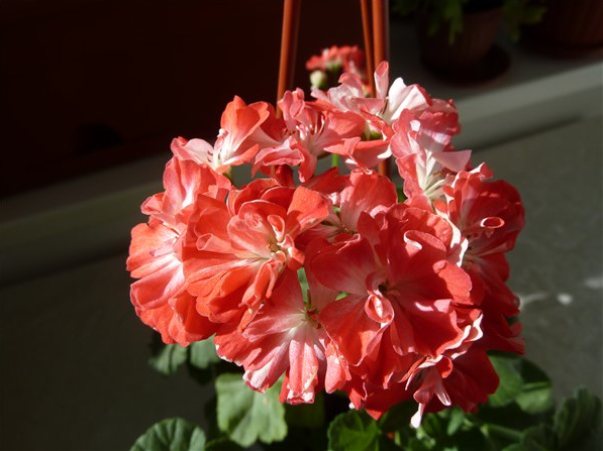
The reverse side of the petals is almost white, so it gives the impression of two colors.
Other varieties
The list can be supplemented with the following varieties:
| Name | Inflorescences |
| le Pirat | Red |
| Pac viva maria | White with a crimson spot at the base of the petals |
| Lake | Pink, almost white towards the edge |
| The plenum | Changes from blue to lavender |
| Elmsett | Cream with red dots |
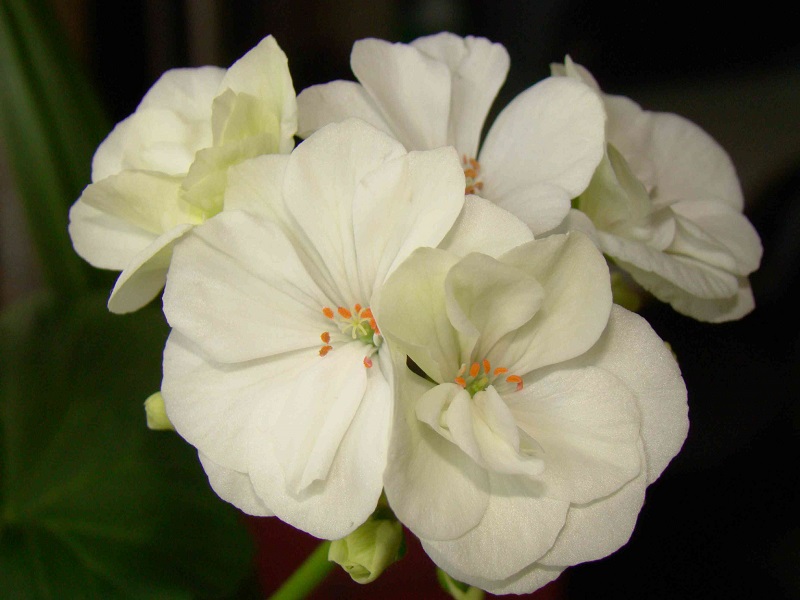
White terry geranium (Delta Pearl, Artic Princess, Joan of Arc, PAC Blanche Roche) is especially popular with florists.
Descriptions and photos of fragrant pink geranium
Scented Geranium is a straight, branched evergreen shrub that grows up to 1.3 m in height and up to 1 meter in width. When the plant is young it is herbaceous, but over time the branches become woody. The stems are fleecy and the leaves are covered with many glandular hairs that give them a soft, velvety texture. The leaves have a strong rose-scented aroma. The leaves are heart-shaped at the base, palmate-lobed, medium green. The flower has 5 light pink petals, which are held in pseudo-umbrellas or are freely located. Each petal has a distinctive set of crimson colored stripes running from center to edge. The flowering period is from late winter to summer, with a peak in the spring.
Fragrant pelargonium will beautifully complement your garden
The wild variety of Pelargonium Graveolens is quite rare and limited to only two areas in South Africa. There are hot summers and mild winters with a lot of rainfall. Pelargonium grows in hilly or mountainous areas, usually in sheltered and humid places. All other varieties are hybrids derived from wild species. Many varieties of such hybrids are highly valued by gardeners as ornamental plants.
ferns geranium species
Since ancient times, various varieties of scented geraniums have been developed and are still actively used commercially. Essential oils are used in perfumery and aromatherapy.
The genus Pelargonium is one of five in the Geraniaceae family, with over 800 species. Therefore, the name "geranium" is used as a household name for many varieties of Pelargonium and other cultivars of this plant, although it is a separate genus.
The aromatic geranium family is an important food source for some Lepidoptera species in their native regions.
Description
Geranium or crane, from the point of view of scientific classification, is the name of the genus (Geranium), belonging to the geranium family. This is a fairly numerous genus, it includes more than 400 species of various shapes that grow in many parts of the world. Plants from the genus geranium are characterized by petioled leaves with a very diverse leaf shape.
Geranium has very beautiful and fairly large flowers, each of which consists of 5 sepals and 5 petals. The five-lobed corolla, which forms an almost perfect circle when opened, can be white, purple, blue or violet, depending on the species. Each peduncle can have from one to three flowers. The fruit, which forms after rapid flowering, resembles a crane's beak in shape (hence the second name).
This family includes another genus - Pelargonium (Pelargonium), whose habitat is South Africa. The genus includes about 250 species, and it is he who is the ancestor of most of the known indoor varieties. Plants belonging to the genus Pelargonium have well-branching erect or creeping stems. Petiole leaves can have a simple, finger-like, or dissected leaf blade. Most species of pelargonium are photophilous and are distinguished by very beautiful and lush inflorescences, resembling umbrellas in shape.
Geranium and pelargonium are very often confused and this is not surprising, because they are closely related plants belonging to the same family, but nevertheless, according to the scientific classification, these are two different genera, each of which has its own species.
Plant varieties and popular winter-hardy varieties
Many varieties tolerate winter frosts well. Among them, the most popular are the following examples:
- Canon Mills. The height of the plant is only 15 cm. The petals are double pink with a purple tint and dark veins;
- Max Fry. The bushes reach a height of 20 cm. The beautiful pink petals have dark pink veins. The plant is unpretentious, adapts to any weather conditions;
- Horizon. Beautiful geranium of long flowering.The flowers are bicolor with white eyes. Used in landscape design. Since the bushes are compact, the plants are hung in pots;
- Striatum. This red geranium reaches a height of 10-15 cm. The flowers are small, light pink in color with dark veins and a central eye. Found on sale under the name Lancastrense;
- Alan Blum is a luxurious and common variety. The flowers are light pink with dark veins. The plant is unpretentious. Grown in many climates;
- Album. The variety is translated from Latin as "white". This is understandable, because the flower has white petals. The height of the bush is 30 cm. Abundant flowering;
- Maverick. The bush is about 20-30 cm high. The inflorescences are large, giving beautiful hemispherical flowers of different shades. The variety is indifferent to temperature extremes.
For your information! Geranium is officially called Geranium sanguineum. Another Russian name is pelargonium. Also, gardeners call geranium a crane for the appearance of the fruit.
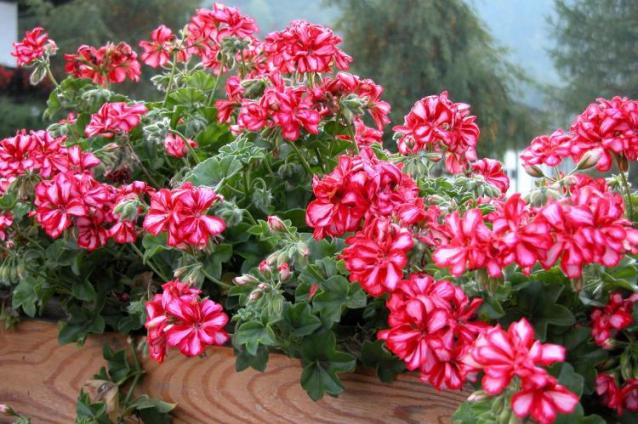
Magnificent pelargonium has many names
Reproduction
Geranium is grown equally well from cuttings and seeds. Proper drainage and soil fertilization is the key to success
This is especially important if the flowers are growing in pots. It goes without saying that every weed is immediately removed even from the pot.
I would like to dwell on the issue of geranium breeding. It can be done in two ways:
- Seed, not very popular among florists. However, if you are engaged in breeding varieties for amateurs to experiment, the most correct one;
- By cuttings, which, in turn, are of two types.
I never wondered what the flowers are called, of course, until the time when geranium became my hobby. I know that there are more than two hundred species of these beautiful plants in the world. At home I grow several varieties - Angel, Terry, Pink. I make various experiments with these plants, they have taken root well in my house and in the garden.
Read also: Shieldweed: planting and care, fern types and varieties
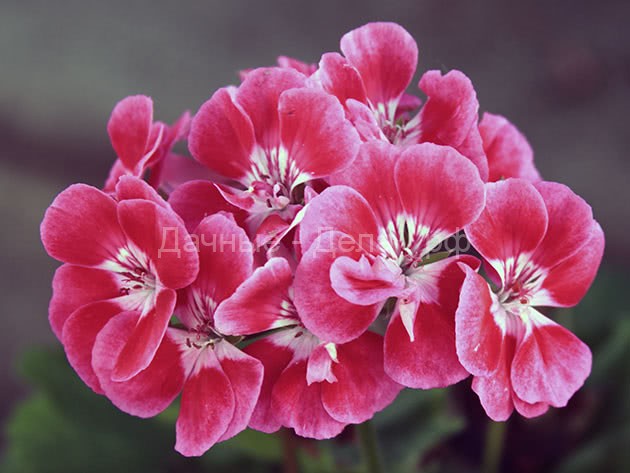
You should not start many varieties, it is better to engage in breeding, create your own varieties, provide yourself with high-quality seed material. To this I want to add that geranium seeds are easy to sell if you really seriously devote yourself to such a hobby.
When I started to seriously engage in floriculture, I asked what benefits and harm my favorite plant can bring. Caring for my little son pushed me to this.
A beautiful large-colored geranium, red, pink or purple, after inhaling its scent for a while, will relieve a headache. If you roll the leaves into tubes, put them in your ears, the effect of the action will increase significantly. The most effective is pelargonium of bright red color.
